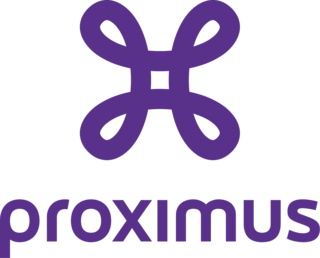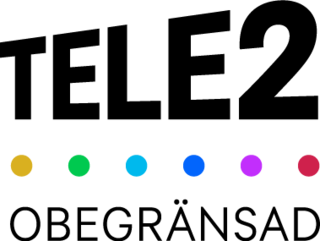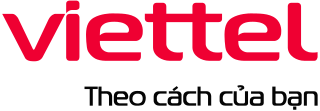Related Research Articles
Telecommunications in Namibia include radio, television, fixed and mobile telephones, and the Internet.
Nepal's telecommunication network has increased over the years significantly, with the number of telephone users reaching 40,789,198 subscribers as of 14 May 2019.

The Proximus Group is a provider of digital services and communication in Belgium and the international markets. In Belgium, its main products and services are offered under the Proximus, Scarlet, and Mobile Vikings brands. The Group is also active in Luxembourg as Proximus Luxembourg SA, under the brand names Tango and Telindus Luxembourg, and in the Netherlands through Telindus Netherlands. The Group's international carrier activities are carried out by BICS and Telesign one of the world's leading voice carriers and the largest provider of mobile data services worldwide. Proximus Accelerators, its ecosystem of IT partners, support companies in their digital transformation.

Magyar Telekom Nyrt. is one of the leading Hungarian telecommunications service provider company. It is a subsidiary of Deutsche Telekom.

Tele2 AB is a provider of mobile and fixed connectivity, telephony, data network services, TV, streaming and global Internet of Things services, amongst others, to consumers and enterprises. It is headquartered in Kista Science City, Stockholm, Sweden. It is a major mobile network operator in Sweden, Russia, Estonia, Latvia and Lithuania.

M1 Limited is a Singaporean telecommunications company and one of the major telcos operating in the country. M1 was founded in 1994 and traded on the Singapore Exchange from 2002 to 2019. M1 is a subsidiary of the Keppel Corporation and Singapore Press Holdings through their joint venture, Konnectivity.

Kyivstar is a Ukrainian telecommunications company, providing communication services and data transmission based on a broad range of fixed and mobile technologies, including 4G (LTE) in Ukraine.

Claro Company, known as Claro Mexico or simply Claro, is a Mexican company part of América Móvil, a Mexican telecom group. Claro serves clients in Argentina, Brazil, Chile, Colombia, Costa Rica, the Dominican Republic, Ecuador, El Salvador, Guatemala, Honduras, Nicaragua, Panama, Paraguay, Peru, Puerto Rico and Uruguay. The company's name means "bright," "clear," and also "of course," in both Portuguese and Spanish.

Sri Lanka Telecom PLC, doing business as SLT-MOBITEL, is the national telecommunications services provider in Sri Lanka and one of the country's largest companies with an annual turnover in excess of Rs 40 billion. The company provides domestic and corporate services which include fixed and wireless telephony, Internet access and IT services to domestic, public and business sector customers. As of 2018 SLT-MOBITEL was Sri Lanka's second largest mobile network operator with over 7.9 million subscribers.

Emirates Integrated Telecommunications Company P.J.S.C., commercially rebranded as du in February 2007, is one of the two main telecom operators in the United Arab Emirates. du offers fixed line, mobile telephony, internet and digital television services across the UAE. It also provides carrier services, a data hub, internet exchange facilities and satellite service for broadcasters. It expanded its services in support of economic and social transformation of UAE and operates subsidiaries such as EITC Investment Holdings Limited, Edara, Smart Dubai Platform Project Company LLC and EITC Singapore PTE. LTD.
Before the era of internet business in Indonesia, internet connections could only be found at a few leading universities. By using UUCP, university servers in Indonesia exchange information with other university servers in the world through their respective gateways. In 1994, the internet business in Indonesia was started, marked by the granting of an internet service provider (ISP) company license issued by the Indonesian government to PT. Rahajasa Media Internet or RADNET.
The Internet in Pakistan has been available since the early 1990s. Pakistan has about 124 million internet users, making it the 7th-largest population of internet users in the world. Information and communications technology (ICT) is one of the fastest growing industries in the country. In 2001 just 1.3% of the population used the Internet. By 2006 this figure had grown to 6.5% and in 2012 to 10.0%. As of July 2021; the percentage of internet users in Pakistan is 54%, which translates into approximately 118 million citizens having access to internet.

The XT Mobile Network is a UMTS and LTE mobile network run by Spark New Zealand. The network was initially built nationwide on WCDMA/UMTS 850 MHz, with 2100 MHz infill in major urban areas. The UMTS network is HSPA+ enabled, with a maximum downlink transmission rate of 21.1 Mbit/s and an uplink rate of 5.2 Mbit/s attainable for capable hardware. HSPA+ has a theoretical maximum of 56 Mbit/s download speed and 22 Mbit/s upload speed. Then under Spark 4G LTE is being built out. The network is not 2G capable, Telecom never operated a public GSM network.

In telecommunications, 5G is the fifth-generation technology standard for broadband cellular networks, which cellular phone companies began deploying worldwide in 2019, and is the successor to 4G networks which provide connectivity to most current cellphones.

Viettel or Viettel Group, formally the Viettel Military Industry and Telecoms Group, is a Vietnamese multinational telecommunications company headquartered in Hanoi, Vietnam. Viettel is the largest mobile network operator in Vietnam. It is a state-owned enterprise and operated by the Ministry of National Defence, making it practically a military-associated corporation.
Inwi is a telecommunication company in Morocco. one of the three major telecom company in the country, It is a subsidiary of the group SNI and the Kuwaiti group Zain.

Airtel India commonly known as Airtel, is the second largest provider of mobile telephony and third largest provider of fixed telephony in India, and is also a provider of broadband and subscription television services. The brand is operated by several subsidiaries of Bharti Airtel, with Bharti Hexacom and Bharti Telemedia providing broadband fixed line services and Bharti Infratel providing telecom passive infrastructure service such as telecom equipment and telecom towers. Currently, Airtel provides 4G and 4G+ services all over India and 5G service in selected cities. Currently offered services include fixed-line broadband, and voice services depending upon the country of operation. Airtel had also rolled out its VoLTE technology across all Indian telecom circles.
References
- ↑ Jat, Dharm Singh; Sieck, Jürgen; Muyingi, Hippolyte N'Sung-Nza; Winschiers-Theophilus, Heike; Peters, Anicia; Nggada, Shawulu, eds. (2018). Digitisation of Culture: Namibian and International Perspectives. Singapore: Springer Singapore. doi:10.1007/978-981-10-7697-8. ISBN 978-981-10-7696-1. S2CID 13683227.
- ↑ Bruijn, Mirjam de (2019). Digitalization and the field of African studies. Carl Schlettwein lecture. Universität Basel. Basel, Switzerland: Basler Afrika Bibliographien. ISBN 978-3-905758-98-6.
- ↑ Singh, Dharm; Sieck, Jürgen; Muyingi, Hippolyte N'Sung-Nza; Winschiers-Theophilus, Heike; Peters, Anicia; Nggada, Shawulu (2018). Digitisation of Culture: Namibian and International Perspectives. Heidelberg: Springer. ISBN 978-981-10-7696-1.
- ↑ Barton, James (2023-02-22). "Namibia launches 4G and 5G spectrum auctions". Developing Telecoms. Retrieved 2023-07-31.
- ↑ "Digital in Namibia: All the Statistics You Need in 2021". DataReportal – Global Digital Insights. 2021-02-12. Retrieved 2023-07-31.
- ↑ Observer (2023-06-26). "Telecom Namibia signs contract to fast-track digital transformation – WINDHOEK OBSERVER" . Retrieved 2023-07-31.
- ↑ "CENORED, MTC seal smart metering agreement - Business Financial Website". thebrief.com.na. Retrieved 2023-07-31.
- ↑ Chitimira, Howard (2023). Financial inclusion and digital transformation regulatory practices in selected SADC countries. South Africa, Namibia, Botswana and Zimbabwe. Springer.
- ↑ Mare, Admire; Woyo, Erisher; Amadhila, Elina M. (2023). Teaching and learning with digital technologies in higher education institutions in Africa. Case studies from a pandemic context. Routledge.
- ↑ Mbangula, Daniel Kwalipo (2024-07-01), Khosrow-Pour, D.B.A., Mehdi (ed.), Exploring the Integration of ICT in Public Sector Management in Namibia, Advances in Information Quality and Management, IGI Global, pp. 1–13, doi:10.4018/978-1-6684-7366-5.ch039, ISBN 978-1-6684-7366-5 , retrieved 2023-07-31